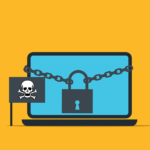
Image by mohamed Hassan from Pixabay
By Henry Brown
Ransomware is a type of malware that encrypts your files and data, lockers them away with a personal password, and then demands money to unlock them. If you don’t pay up in time, the locked files stay locked forever. In this article, we explain what ransomware is, how it can attack you and your business, and the steps you need to take to minimise the risk of infection and recover from an attack if one occurs
What is ransomware?
Ransomware is malware that hijacks your computer and encrypts your files. Hackers then demand money in exchange for a decryption key that you can use to unlock your data again. If you don’t pay up, they may promise to give the decryption key to you anyway, but that doesn’t always happen.
In some cases, the program erases your data completely if you don’t pay up. In other cases, it has no “off” switch and keeps encrypting files until your computer becomes too slow to function.
How does ransomware work?
Most ransomware attacks start with an email that contains a link or attachment that has malicious code. If you click on the link or download and open the attachment, the malware runs and installs itself on your computer. If your computer is connected to a network, the malware may also try to infect the other computers on that network.
3 ways to mitigate the risk of ransomware
-Invest in cyber insurance: If you’re a business that handles sensitive data, you should consider cyber insurance. This form of coverage may reimburse you for the costs of ransomware removal and repairs, such as hiring a cyber-incident response firm to help you “kill the virus” and recover your data.
-Use a “safe” computer: If you’re concerned about falling victim to ransomware, use a “safe” computer that you don’t store any sensitive data on. Ideally, the computer should have been erased and put in a “factory reset” state before you started using it. Also, use antivirus software, firewall software, and a file-encryption software.
-Practice cyber hygiene: You should review your company’s security practices to see if you can make any improvements. Make sure you have the latest versions of your computer’s operating system and software. You should also follow safe Internet browsing practices and limit the amount of sensitive data you store on your computer.
2 ways to recover from ransomware
-Maintain up-to-date backups: If you keep an up-to-date backup of your data, you’ll have a safety net in place that will allow you to restore your data if it’s ever compromised by ransomware. This can be a cloud-based backup, an external hard drive, or a combination of the two. You should also keep a copy of your encryption key. This is the key the hackers use to encrypt your data; you need it to decrypt your data again once the ransomware is gone.
-Deal with it as an incident: If you don’t have a backup, you can still recover from a ransomware attack. You just need to deal with it as an incident, which means you need to take swift action to mitigate the damage and then contact a professional such as Kenny Natiss to help you clean up and recover.
Conclusion
Ransomware is a type of malware that encrypts your files and data, keeping them inaccessible should you not pay the perpetrator.
To protect yourself from this type of attack, make sure you have a reliable antivirus software installed on your computer, and make sure you practice cyber hygiene. You should also invest in cyber insurance to protect yourself against potential ransomware attacks and data breaches.
__________
Henry Brown is an online marketing executive. When he isn’t talking shop, he’s roaming the streets of London, uncovering the extra-ordinary in the ordinary.
